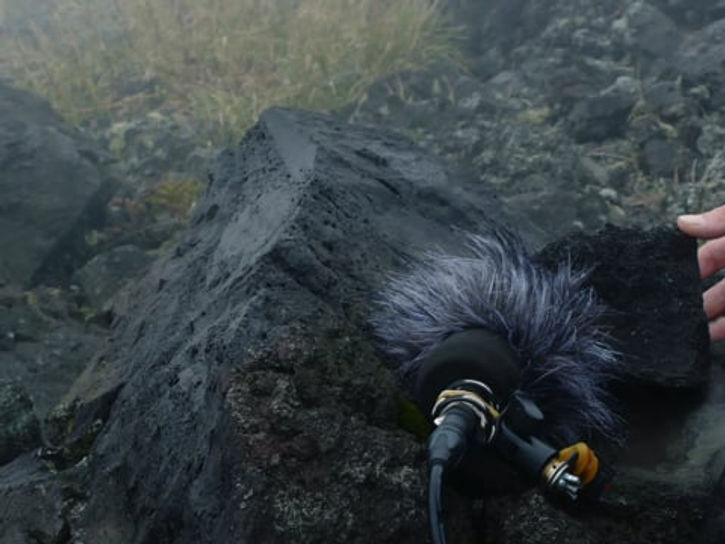SHINGO YOSHIDA
Seeking Hidden
© 1999 - 2024 Studio SHINGO YOSHIDA. All rights reserved.
Geister heimsuchen (Haunting Spirits)
FILM | PHOTOGRAPHY
Location: Tokyo - Izu Oshima, JAPAN
Year: 8-10 October 2019
Duration: 12 min 10 sec
Format: 4K ProRes 422 HQ
Sound: Christoph Rothmeier, Shingo Yoshida
Expotision: Shingo Yoshida & Christoph Rothmeier -geister heimsuchen-@S.Y.P Tokyo JAPAN
19-28.October.2019
「Haunting Spirits」は、かつて流刑者たちが過ごした伊豆大島の荒々しい活火山の環境を舞台に、彼らの魂の声を感じ取るようなプロジェクトです。昔の絵葉書や島の歴史を手がかりに、波や嵐の轟音を通じて、人々が抱えていた苦しみや希望、そして未練のような感情を音に記録しました。
*重低音のためヘッドフォンを使用してください。
東京都
流刑地・伊豆大島
伊豆大島(東京)は、伊豆諸島の中で最大の島であり、その歴史は古代にさかのぼります。島は日本列島の火山活動によって形成され、現在も活発な火山である三原山がその中心にあります。
歴史的に、伊豆大島は流刑地として知られており、江戸時代には多くの罪人がこの島に流されました。島の孤立した地理的条件が流刑地として適しているとされ、犯罪者や政治的に不都合とされた人物が送り込まれたのです。特に有名な例として、鎌倉時代の僧・日蓮が幕府によって一時的に流されたことが挙げられます。さらに、伊豆大島は源為朝、キリシタン、武田信玄の孫である武田信道、赤穂浪士の遺児らの流刑地にもなりました。
刑罰の記録と伝承
大島の伝承や古文書には、以下の刑罰が行われたと記されています:
・斬首
古老の口承によると、流人の中でも悪徒とみなされた者は斬首されたとされています。
・簾巻
簾(すだれ)に巻かれ、その上を幾重にも縛り付けた後、赤禿の断崖から放り投げる処刑法です。
・棒縛り
罪人の両手を広げて棒を当て、十字形に縛り付けた状態で昼間は往来にさらされ、逃亡を防ぐとともに恥を与える刑罰です。
English:
Geister heimsuchen (Haunting Spirits)
"Haunting Spirits" is a project set in the rugged volcanic environment of Izu Oshima, once home to exiled convicts. Inspired by old postcards and the historical backdrop of the island, the project captures the voices of their souls through the roaring sounds of waves and storms. It seeks to document the pain, hopes, and lingering emotions of those who once lived there.
*Please use headphones to fully experience the deep bass sounds.
Tokyo
Exile Island: Izu Oshima
Izu Oshima (Tokyo) is the largest island in the Izu archipelago, with a history that dates back to ancient times. The island was formed by volcanic activity along the Japanese archipelago and is still dominated by the active volcano, Mount Mihara.
Historically, Izu Oshima is known as an island of exile. During the Edo period, many convicts were sent to this isolated island. Its remote location made it an ideal place for exile, and it became a destination for criminals and individuals deemed politically inconvenient. One of the most notable examples is the Buddhist monk Nichiren, who was temporarily exiled here by the Kamakura shogunate.
Additionally, Izu Oshima served as a place of exile for historical figures such as Minamoto no Tametomo, Christians, Takeda Nobumichi (grandson of Takeda Shingen), and the orphaned children of the Forty-seven Ronin.
Records and Traditions of Punishment
Historical accounts and folklore from Izu Oshima document the following punishments:
・Beheading
: According to oral tradition, convicts deemed particularly dangerous were executed by beheading.
・Sudaré: Wrapping
This unique punishment involved wrapping the convict in a bamboo mat (sudaré), binding them tightly, and throwing them off the cliffs of Akahage.
・Pole Binding: Convicts were bound in a cruciform position with poles to prevent escape and were publicly displayed during the day, serving both as a deterrent and as a means of humiliation.
Français:
Geister heimsuchen (Haunting Spirits)
"Haunting Spirits" est un projet situé dans l'environnement volcanique accidenté de l'île d'Izu Oshima, autrefois lieu d'exil pour les condamnés. Inspiré par d'anciennes cartes postales et le contexte historique de l'île, ce projet capture les voix de leurs âmes à travers les rugissements des vagues et des tempêtes. Il cherche à documenter la douleur, les espoirs et les émotions persistantes de ceux qui y ont vécu.
*Veuillez utiliser un casque pour apprécier pleinement les sons graves.
Tokyo
Île d’exil : Izu Oshima
Izu Oshima (Tokyo) est la plus grande île de l’archipel d’Izu, avec une histoire qui remonte à l’Antiquité. L’île a été formée par l’activité volcanique de l’archipel japonais et est encore dominée par le volcan actif, le mont Mihara.
Historiquement, Izu Oshima est connue comme une île d’exil. Pendant la période Edo, de nombreux condamnés furent envoyés sur cette île isolée. Sa position éloignée en faisait un lieu idéal pour l’exil, accueillant des criminels et des figures jugées politiquement gênantes. L’un des exemples les plus célèbres est celui du moine bouddhiste Nichiren, temporairement exilé ici par le shogunat de Kamakura.
De plus, Izu Oshima a servi de lieu d’exil pour des figures historiques telles que Minamoto no Tametomo, des chrétiens, Takeda Nobumichi (petit-fils de Takeda Shingen) et les enfants orphelins des quarante-sept rônins.
Les châtiments et les traditions
Les récits historiques et les traditions d'Izu Oshima documentent les châtiments suivants :
・Décapitation
: Les traditions orales suggèrent que les condamnés jugés particulièrement dangereux étaient exécutés par décapitation.
・Enroulement dans une natte
: Cette punition unique consistait à enrouler le condamné dans une natte de bambou (sudaré), à le lier fermement, puis à le jeter des falaises d'Akahage.
・Attache à un poteau
: Les condamnés étaient attachés en position cruciforme avec des poteaux pour éviter toute fuite et étaient exposés publiquement en journée, servant à la fois de moyen de dissuasion et d'humiliation.








